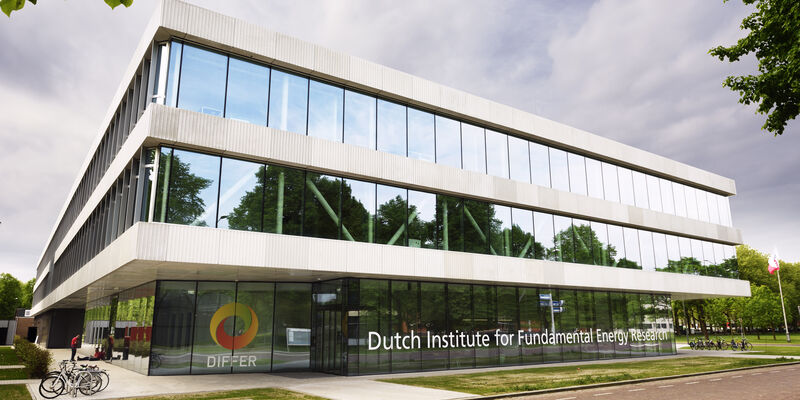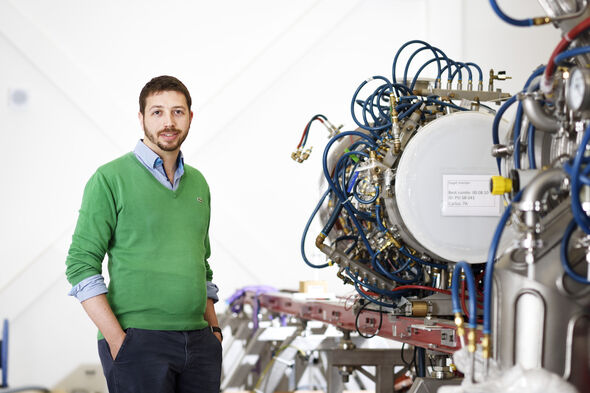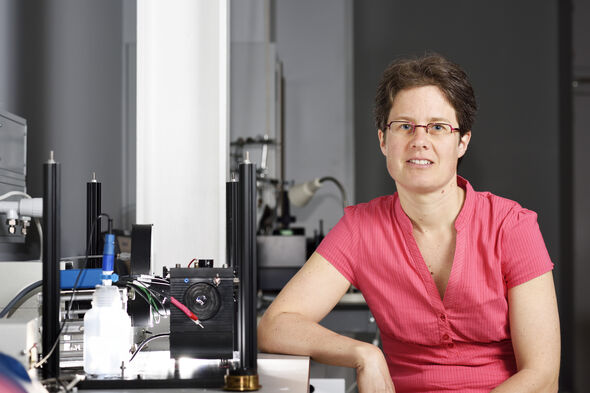
- Research , Campus
- 21/05/2015
DIFFER-upon-Dommel
Last week, employees of the Dutch Institute for Fundamental Energy Research (DIFFER) started in their brand new home on campus. To get an idea of what DIFFER researches and how that connects with the TU/e community, Cursor took stock and interviewed several researchers at the institute just before the move.
On May 11, 140 DIFFER employees moved into their new offices on TU/e campus. Being physically close, existing collaborations between the institute and the university – fusion experts Marco de Baar and Tony Donné were already part-time professors at TU/e, for example, as is DIFFER director Richard van de Sanden -will become even easier. DIFFER and its employees will have TU/e facilities at their disposal, including NanoLab@TU/e, lecture theaters, the library, and the sports center -almost as if DIFFER were the tenth TU/e department. And it works both ways, because the experimental setups and workshop of DIFFER are open to TU/e people, too.
Research at DIFFER can be divided into two themes: nuclear fusion and solar fuels. Fusion research was an important subject already when the institute was still known as the FOM Institute for Plasma Physics Rijnhuizen. The institute was and is contributing to preparations for ITER, the experimental nuclear fusion reactor that is being constructed at the Cadarache research center in the south of France.
The aim of ITER is to generate nuclear fusion in extremely hot plasma that is being held in place by means of magnetic fields. DIFFER has one-of-a-kind setups to mimic the conditions near the fusion reactor wall: plasma generators Magnum-PSI and Pilot-PSI. ITER uses these to test and research how wall materials hold up under realistic plasma pressure.
The dynamics of the fusion plasma greatly affect the efficiency of the reactor as well. That’s why DIFFER works on computer simulations of the plasma and develops diagnostic techniques to measure the plasma parameters. The institute also develops control systems to regulate the conditions inside the plasma and is thinking of the best ways to maintain the reactor.
When in 2012 Rijnhuizen changed its mission and continued as DIFFER, a new line of research was introduced gradually: one that focuses on efficiently storing sustainably generated energy (particularly sunlight) as fuels. The fuels are needed to store the sustainably generated energy for an extended period of time and to transport it, so the energy may be used wherever and whenever.
The basic components of these solar fuels are carbon dioxide and water. And since those happen to be released upon combustion, it’s a closed cycle. In their search for solar fuels, DIFFER investigates both direct ways to create hydrogen and oxygen from sunlight, and catalyst processes to store electrical energy in chemical compounds. DIFFER plans to set up a kind of solar-fuel annex for the group of University Professor René Janssen. They are now looking for a researcher to lead the group.
“We are getting closer to ITER conditions still”
Brit Thomas Morgan works with Magnum-PSI, which is the only setup in the world that can mimic the ITER exhaust being exposed to hot particles experimentally. A plasma is directed by magnetic fields to a target. Magnum-PSI is fifteen meters in length and the lab it is located at has five-centimeter thick iron walls to keep the magnetic field inside. “One of the great challenges for ITER will be finding a material that can withstand the electricity coming from the blazing hot particles from the plasma”, says Morgan. “The heat flux, as it is called, is in the dozens Megawatts per square meter, comparable to that of the sun. We use the magnetic fields to guide the plasma and keep it warm, and so we create conditions that are similar to those in ITER.”
Whereas in Nieuwegein they worked with copper coils, Eindhoven will have a superconducting magnet at its disposal, says Morgan. The magnet enables DIFFER to expose materials to the plasma pretty much continuously. “So far, we have had to work with pulses lasting only a few seconds lest the coils get too hot. Soon, that will be a thing of the past and that will bring us closer to the actual conditions in ITER, which will be running for six to seven minutes on end.” Morgan and his colleagues plan to study how materials react to being exposed to extreme plasma conditions, but they also intend to find out if perhaps the plasma flow can be cooled by injecting a cold gas. The new building will also feature an ion beam facility for in situ material research, a unique extra for both the PSI lab and the Solar Fuels group.
Morgan’s group has been working in close collaboration with TU/e for years, both with Professor Niek Lopes-Cardozo’s Fusion group and the interdisciplinary master track Science and Technology of Nuclear Fusion. On top of that, DIFFER and TU/e appointed six common PhD candidates last year, several of whom are supervised by Morgan himself. “It has become much more convenient to supervise those candidates. If we want to meet, we just walk across campus.”

“Definitive materials not found yet”
Anja Bieberle from Germany is employed by DIFFER, but has been working at the Institute for Complex Molecular Systems (ICMS) at TU/e for a year now. At ICMS, she works with a small-scale research setup for photoelectronic experiments. She searches for materials (particularly metal oxides) that, in thin layers, might function as electrodes in fuel-producing photoelectrochemical cells. Sunlight splits water in these cells into hydrogen and oxygen. Then, the hydrogen can be combined with carbon extracted from CO2 to form liquid fuel, she explains. First, however, the first essential step must be perfected. “We have to be much more efficient. We all agree the right materials have not been discovered yet.”
Bieberle has to compete with methods that generate electricity in standard solar cells first, which is then used for chemical conversions to produce fuel – a process that DIFFER is researching as well. She also stresses that electrolysis devices (that can split water) have been around for a while already. “But that requires two steps. We want to cover the entire process at once.”
During her time at TU/e, Bieberle has connected with groups of various departments. Not only did she use the facilities at NanoLab@TU/e, but she also worked at Bert Koopmans’ group Physics of Nanostrcutures, and frequented the labs of professors René Janssen (Macromolecular and Organic Chemistry) and Emiel Hensen (Molecular Catalysis) to create and study thin layers. She is now planning to collaborate with the mechanical engineers of Control Systems Technology to develop simulations to optimize her electrochemical system.
A joint project within DIFFER is at hand, too. “Materials that have been exposed to the plasma from the Magnum-PSI turn out to have a nanostructure that might just be suitable for use in electrodes for electrochemical processes. We are working on the transfer of that effect to thin layers as we speak.”

Discussion